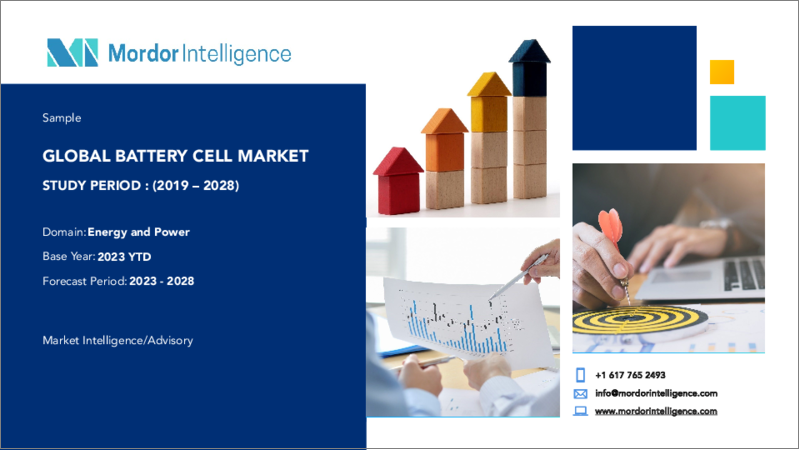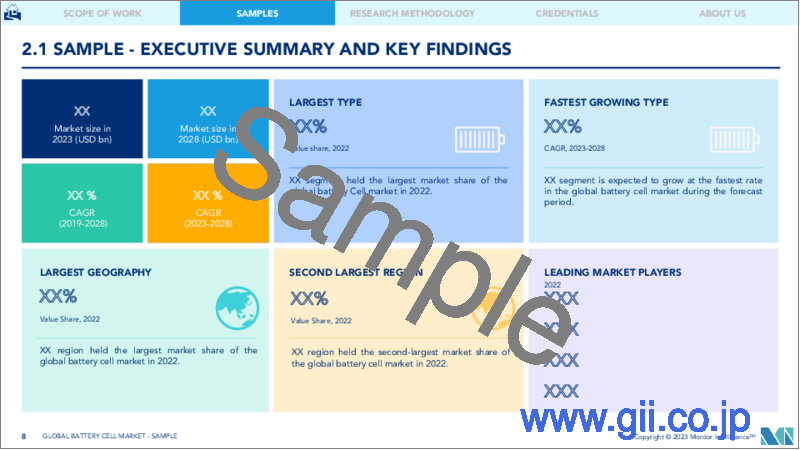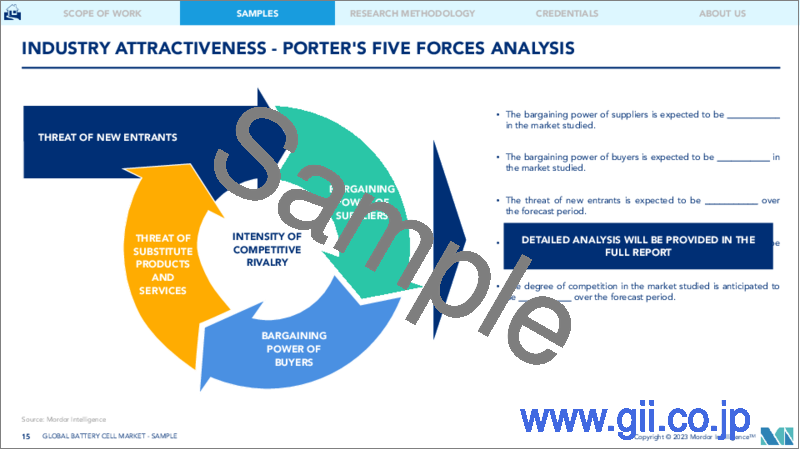|
|
市場調査レポート
商品コード
1190032
バッテリーセル市場- 成長、動向、予測(2023年~2028年)Battery Cell Market - Growth, Trends, and Forecasts (2023 - 2028) |
||||||
|
● お客様のご希望に応じて、既存データの加工や未掲載情報(例:国別セグメント)の追加などの対応が可能です。 詳細はお問い合わせください。 |
|||||||
| バッテリーセル市場- 成長、動向、予測(2023年~2028年) |
|
出版日: 2023年01月18日
発行: Mordor Intelligence
ページ情報: 英文 120 Pages
納期: 2~3営業日
|
- 全表示
- 概要
- 目次
バッテリーセル市場は、予測期間中に14.32%のCAGRを記録し、2022年には420億8000万米ドルに達すると予測されています。
調査した市場は、2020年にCOVID-19のパンデミックの影響を受けたもの、回復してパンデミック前の水準に達しました。バッテリーセルに対する需要の高まりは、予測期間中の市場の成長を後押しすると予想されます。また、主にリチウムイオン電池の価格低下によって促進された電気自動車の急速な普及は、調査対象市場の成長を促進すると予想されます。しかし、電池用金属を直接入手できないことが、市場の成長を抑制しています。技術の進歩に伴い、スマートガジェットの価格は低下し、一般消費者が購入しやすい価格になると予想され、予測期間中に成長機会を提供するものと期待されています。
アジア太平洋地域は市場を独占しており、予測期間中に最も高いCAGRで推移すると予想されています。需要の大半は、中国やインドなどの国々からもたらされています。
主な市場動向
プリズムセルセグメントが市場を独占すると予想される
プリズムセルは、1990年代初頭に導入された電池業界のバッテリーセルの一種です。最新の角型電池は、より薄いサイズへの要求を満たし、チューインガムの箱や小さなチョコレートバーのような上品なパッケージに包まれています。角型セルは、レイヤーアプローチによって空間を最適に利用します。また、角型セルを巻いて平らにし、疑似角型ジェリーロールのようにしたものもあります。これらのセルは、800mAhから4000mAhまでの携帯電話、タブレット端末、薄型ノートパソコンに多く使用されています。
角型セルは、溶接されたアルミニウム製ハウジングにパッケージされた大型のものもあり、20~50Ahの容量があります。これらは主にエネルギー貯蔵システムや、ハイブリッド車や電気自動車の電動パワートレインに使用されています。そのため、角型セルのサイズが大きいと、電子自転車や携帯電話などの小型機器には不向きです。リチウム角型電池は、体積当たりの出力とエネルギーの比率が最も優れているため、マテリアルハンドリング機器(MHE)に適した技術です。そのため、これらの電池はエネルギーを大量に消費するアプリケーションに適しています。
これらのバッテリーセルタイプは、大容量で角柱状のため、4つのセルを接続して12Vバッテリーパックを作ることが容易で、スペース利用が向上し、柔軟な設計が可能なことから人気を博しています。公称容量とkWhエネルギーが最も高く、電池全体のエネルギー密度も他のセルより高いです。これらのバッテリーセルは膨張の影響を受けません。他のバッテリーセルと比較してこのような利点があるため、エンドユーザーにとって好ましいものとなっています。しかし、製造コストが高く、熱管理の効率が低く、サイクル寿命が円筒形設計よりも短い場合があります。
2022年1月、韓国の電池大手LG Energy Solution Ltdは、リチウムイオン電池のラインナップに角型セルタイプを追加する計画だっています。同社は、顧客層を広げるために角型形状をポートフォリオに加える可能性があることを明らかにしました。EVトップメーカーのテスラやフォルクスワーゲンが2021年にいち早く角型タイプを採用したことで、現在中国のCATLが主導するLFP(リチウム-鉄-リン酸塩)を使った角型セルへの移行がサムスンSDIやSKオンといった現地競合他社で進んでいます。
韓国勢は、フォルクスワーゲンが2030年までに電気自動車の最大80%に角型電池を採用することを決めた後、サムスンSDIとSKオンがともに角型パッケージに目をつけた。2022年7月、フォルクスワーゲングループは、ドイツ・ザルツギッターに初のバッテリーセル工場を設置すると発表しました。プリズム型統一セルを最大で80%のモデルに採用すると発表しました。この工場は2025年までに生産を開始する予定であり、SalzGigaと名付けられた新しいセル工場は、電気自動車約50万台分に相当する40GWhの年間生産能力に達すると予想されています。
したがって、上記の要因により、角形セルセグメントは予測期間中に大きな成長を示すことが期待されます。
アジア太平洋地域が大幅な成長を遂げる見込み
アジア太平洋地域は、家電製品の最大の製造・輸出国であり、その生産能力の高さから、主に中国が支配的な地位を占めています。この地域は、予測期間中、民生用電子機器の製造部門を支配すると予想されます。したがって、アジア太平洋地域の電池市場は、民生用電子機器分野の成長から恩恵を受けると予想されます。
中国は、幅広い用途で電池を製造・利用する世界有数の国です。2020年、中国は世界のリチウムイオン電池の76%、世界の電気自動車の44%を製造しています。同国はエレクトロニクス分野のハブであり、すなわち2021年には携帯電話の総輸出の48.4%近くが中国からのものであり、中国はバッテリーセル産業における重要なマーケットプレーヤーとなっています。
韓国は、主に家電製品、家庭用品、電気自動車のバッテリーに使用される円筒形および角柱形のセルの主要消費国です。近年、韓国の半導体輸出の減速が予想される中、電気自動車用電池が新たな柱として台頭しており、今後数年間で韓国経済を牽引することが期待されています。
GODIは2022年7月、円筒形リチウムイオン電池「NMC811 3.65V-4.5Ah」21700個でインド規格局(BIS)の認証をインドで初めて取得しました。同社は、2024年までにリチウムイオン電池の製造工場を設立することを目指しています。今回認証されたセルは、インドの電気自動車やESS分野のニーズに対応するものと思われます。このように、今後の投資によって、予測期間中にインドにおけるバッテリーセル市場の成長が促進されることが期待されます。
したがって、上記の要因により、アジア太平洋地域は予測期間中に大きな成長を遂げると予想されます。
その他の特典
- エクセル形式の市場予測(ME)シート
- アナリストによる3ヶ月間のサポート
目次
第1章 イントロダクション
- 調査対象範囲
- 市場の定義
- 調査の前提
第2章 エグゼクティブサマリー
第3章 調査手法
第4章 市場の概要
- イントロダクション
- 2027年までの市場規模・需要予測(単位:億米ドル)
- 最近の動向と展開
- 政府の規制と政策
- 市場力学
- 促進要因
- 抑制要因
- サプライチェーン分析
- ポーターのファイブフォース分析
- 供給企業の交渉力
- 消費者の交渉力
- 新規参入業者の脅威
- 代替品の脅威
- 競争企業間の敵対関係
第5章 市場セグメンテーション
- タイプ別
- プリズム型
- シリンドリカル
- パウチ
- 用途別
- 車載用バッテリー(HEV、PHEV、EV)
- 産業用バッテリー(動力用、定置用(通信、UPS、蓄電システム(ESS)など))
- ポータブルバッテリー(家電製品など)
- 電動工具用バッテリー
- SLIバッテリー
- その他の用途
- 地域別情報
- 北米
- アジア太平洋地域
- 欧州
- 中東・アフリカ
- 南米
第6章 競合情勢
- M&A、コラボレーション、ジョイントベンチャー
- 主要なプレーヤーが採用する戦略
- 企業プロファイル
- BYD Co. Ltd
- Contemporary Amperex Technology Co. Limited
- Duracell Inc.
- EnerSys
- GS Yuasa Corporation
- Shenzhen ACE Battery Co. Ltd
- LG Energy Solution Ltd
- Panasonic Corporation
第7章 市場機会と将来動向
The battery cell market is expected to reach USD 42.08 billion in 2022, registering a CAGR of 14.32% during the forecast period.
Although the market studied was affected by the COVID-19 pandemic in 2020, it recovered and reached pre-pandemic levels. The growing demand for battery cells is expected to boost the market's growth during the forecast period. The rapid adoption of electric vehicles, mainly fostered by the declining price of lithium-ion batteries, is also expected to drive the growth of the market studied. However, the lack of direct access to battery metals is restraining the market's growth. With technological advancements, the price of smart gadgets is expected to decline, making them more affordable to the public, which is expected to provide growth opportunities during the forecast period.
Asia-Pacific dominates the market and is expected to witness the highest CAGR during the forecast period. The majority of the demand comes from countries like China and India.
Key Market Trends
Prismatic Cell Segment is Expected to Dominate the Market
Prismatic cells are a type of battery cell in the battery industry that were introduced in the early 1990s. The modern prismatic cell fulfills the demand for thinner sizes and comes wrapped in elegant packages like a box of chewing gum or a small chocolate bar. The prismatic cells make optimal use of space by using the layered approach. Other designs are wound and flattened into a pseudo-prismatic jelly roll. These cells are mostly found in cell phones, tablets, and low-profile laptops ranging from 800 mAh to 4,000 mAh.
Prismatic cells are also available in large formats packaged in welded aluminum housings and deliver capacities of 20-50 Ah. These are primarily used in energy storage systems and for electric powertrains in hybrid and electric vehicles. Hence, the larger size of the prismatic cells makes them bad candidates for smaller devices like e-bikes and cellphones. Lithium prismatic cells are the preferred technology for material handling equipment (MHE), as the technology provides the best ratio of power and energy per volume unit. Therefore, these battery cell types are better suited for energy-intensive applications.
These battery cell types have gained popularity due to their large capacity and prismatic shape, making it easy to connect four cells and create a 12V battery pack, providing improved space utilization and allowing flexible design. It has the highest Ah nominal capacity and kWh energy and a higher overall battery energy density than other cells. These battery cells are not subject to swelling. Such advantages over other battery cell types make it preferable to the end users. However, it can be more expensive to manufacture, less efficient in thermal management, and have a shorter cycle life than the cylindrical design.
In January 2022, South Korean battery major LG Energy Solution Ltd planned to add a prismatic cell type to its lithium-ion battery lineup. The company revealed that it could add the prismatic form to its portfolio to broaden its customer base. The company's local competitors like Samsung SDI and SK On are moving onto prismatic cells with lithium-iron-phosphate (LFP), currently led by China's CATL, as top EV makers Tesla and Volkswagen adopted prismatic type earlier in 2021.
Korean players, both Samsung SDI and SK On, turned attention to rectangular packaging after Volkswagen decided that up to 80% of its electric vehicles would use prismatic batteries by 2030. In July 2022, Volkswagen Group announced the setup of its first battery cell factory in Salzgitter, Germany. It unveiled the prismatic unified cell would be used in up to 80% of its models. The plant is expected to start production by 2025, and the new cell plant, nicknamed SalzGiga, is expected to reach an annual capacity of 40 GWh, enough for about 500,000 electric vehicles.
Hence, due to the above-mentioned factors, the prismatic cell segment is expected to witness significant growth during the forecast period.
Asia Pacific is Expected to Witness Significant Growth
Asia-Pacific is the biggest manufacturer and exporter of consumer electronics, mainly dominated by China due to its large production capabilities. The region is expected to dominate the consumer electronics manufacturing sector during the forecast period. Hence, the Asia-Pacific battery market is expected to benefit from the growth of the consumer electronics sector.
China is one of the leading countries in the world that manufacture and utilizes batteries in a wide range of applications. In 2020, China manufactured 76% of the global lithium-ion battery and 44% of the global electric vehicles. The country is a hub of the electronic sector, i.e., nearly 48.4% of the total mobile phone export was from China in 2021, making China a significant market player in the battery cell industry.
South Korea is a major consumer of cylindrical and prismatic cells, primarily used in consumer electronics, household items, and electric vehicle batteries. Amid concerns about an anticipated slowdown in South Korean semiconductor exports in recent years, batteries for electric vehicles are emerging as a new pillar, which is expected to propel the country's economy in the coming years.
In July 2022, GODI became the first company in India to receive Bureau of Indian Standard (BIS) certification for its 21700 cylindrical NMC811 3.65V-4.5Ah lithium-ion cells. The company aims to set up a lithium-ion cell manufacturing factory by 2024. The newly certified cells are likely to cater to the needs of the EV and ESS sectors in India. Thus, such upcoming investments are expected to drive the battery cell market's growth in India during the forecast period.
Hence, due to the above-mentioned factors, the Asia-Pacific segment is expected to witness significant growth during the forecast period.
Competitive Landscape
The global battery cell market is fragmented. Some key players in this market (in no particular order) include LG Chem Ltd, Contemporary Amperex Technology Co. Limited, BYD Company Limited, GS Yuasa Corporation, and Panasonic Corporation.
Additional Benefits:
- The market estimate (ME) sheet in Excel format
- 3 months of analyst support
TABLE OF CONTENTS
1 INTRODUCTION
- 1.1 Scope of the Study
- 1.2 Market Definition
- 1.3 Study Assumptions
2 EXECUTIVE SUMMARY
3 RESEARCH METHODOLOGY
4 MARKET OVERVIEW
- 4.1 Introduction
- 4.2 Market Size and Demand Forecast in USD billion, till 2027
- 4.3 Recent Trends and Developments
- 4.4 Government Policies and Regulations
- 4.5 Market Dynamics
- 4.5.1 Drivers
- 4.5.2 Restraints
- 4.6 Supply Chain Analysis
- 4.7 Porter's Five Force Analysis
- 4.7.1 Bargaining Power of Suppliers
- 4.7.2 Bargaining Power of Consumers
- 4.7.3 Threat of New Entrants
- 4.7.4 Threat of Substitutes Products and Services
- 4.7.5 Intensity of Competitive Rivalry
5 MARKET SEGMENTATION
- 5.1 By Type
- 5.1.1 Prismatic
- 5.1.2 Cylindrical
- 5.1.3 Pouch
- 5.2 By Application
- 5.2.1 Automotive Batteries (HEV, PHEV, EV)
- 5.2.2 Industrial Batteries (Motive, Stationary (Telecom, UPS, Energy Storage Systems (ESS), etc.)
- 5.2.3 Portable Batteries (Consumer Electronics etc.)
- 5.2.4 Power Tools Batteries
- 5.2.5 SLI Batteries
- 5.2.6 Other Applications
- 5.3 By Geography
- 5.3.1 North America
- 5.3.2 Asia-Pacific
- 5.3.3 Europe
- 5.3.4 Middle East and Africa
- 5.3.5 South America
6 COMPETITIVE LANDSCAPE
- 6.1 Mergers and Acquisitions, Collaborations, and Joint Ventures
- 6.2 Strategies Adopted by Key Players
- 6.3 Company Profiles
- 6.3.1 BYD Co. Ltd
- 6.3.2 Contemporary Amperex Technology Co. Limited
- 6.3.3 Duracell Inc.
- 6.3.4 EnerSys
- 6.3.5 GS Yuasa Corporation
- 6.3.6 Shenzhen ACE Battery Co. Ltd
- 6.3.7 LG Energy Solution Ltd
- 6.3.8 Panasonic Corporation




